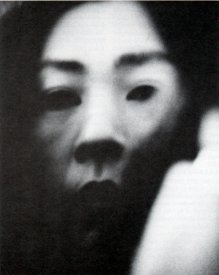The 6th Australian international Video Festival, 1991.
[This entry is edited from the AIVF '91 catalogue entry and a Press Release. - SJ]
Geoffrey Weary - Faraway
Installation at the Art Gallery of NSW, 15-30 Nov. 1991
An elegant and finely nuanced work of poignancy and enigma, Faraway was photographed at the Imperial Palace in central Tokyo on the day of the death of the Emperor Hirohito on the 7th of January 1989, and one week later, outside the palace grounds before the glass encased casket of the mortal remains of the Emperor. Vast crowds gathered on these days to mourn the passing of a 1iving god", Japan's longest reigning monarch and last surviving leader of the Second World War.
The soundtrack of Faraway is based on the recording of events in the world media during the period prior to and immediately after the death of the Emperor - the U.S. Presidential election, the earthquake in Soviet Armenia and the Lockerbie air disaster etc. These sounds are layered with subtle shortwave signals and the voice of the English tenor, Peter Pears, suffusing the work with an ironic sense of bodily transformation.
Geoffrey Weary is an artist working with the mediums of photography, video and installation. His work has been exhibited widely in Australia, featuring in major survey exhibitions including The Adelaide Biennial of Australian Art, Art Gallery of South Australia, 1990, and Perspecta, Art Gallery of New South Wales, 1989.
He recently presented a seminar on his work at the New Museum of Contemporary Art, New York, and is currently working on a new video installation project to be photographed in the Soviet Union.
[Catalogue note by John Conomos}
Faraway Geoffrey Weary
Faraway is concerned with two interrelated conceptual and visual objectives: the radical juxtaposition between old and new technology and the phenomenological nuances of the last fleeting images of life. The latter objective is embodied by the installation's Ophulsian-like camera style that caresses in its meandering scanning mode the very calligraphic textuality of Tokyo. Visually and sonically Faraway contains many moments of highly elaborate stylistics that lie at the core of its thematic concerns. Images and sounds of extraordinary refinement come to the fore and then disappear with the subtle choreographic agility of the diaphanous silk curtain flapping in the breeze. There is an underlying aesthetic drive in FARAWAY to articulate the poetic adventure of translating the invisible into the visible.
The work is crafted in the key of slowmotion videography - we encounter, time and again, sustained kinetic passages of the Emperor's faithful citizen's with their umbrellas paying their last respects at Edo Castle. In these scenes of evocative movement of image and sound (enhanced by suggestive finely calibrated editing) we can sense in clear and vivid terms the central focus and influence the Emperor had in post-war Japan. Relatedly, the overriding poignancy of the Emperor's coming death is rendered in telling resonant images and sounds that echo the traditional aesthetic precepts of Japanese art and life: ambiguity, asymmetry and purity. Thus, we negotiate throughout the work's deeply allusive and multi-layered conceptual and audio-visual configurations scenes depicting Tokyo's futuristic skyline with its electric billboards that resemble the calligraphic architecture of manga comic books, silver trains that crisscross the city with the silent surreal rupture of one of Franju's enigmatic trains that appear in his cinema, elongated raindrops in slow motion that connote fragile dying moments, and the postmodern postmedia surfaces of Tokyo's omnipresent new communication technologies. Aurally, Faraway's polyphonic textures italicise this last point in rich suggestive terms. Overall, these markedly elaborate images and sounds are expressive of the shifting complex aesthetic, cultural and visual connections between Japan and the West.
Faraway's ambient and visually elegant mise-en-scene in association with its simple sculptural mode of expression indicates Weary's malleable capacity to create video that is critically informed of its own brief but intricate history as a dominant temporal art form of our time. There is a theoretical and stylistic endeavour here to maximise the idea of video as a fine arts discourse, to distinguish video from the other more illusionistic art forms. What informs Faraway also is the artist's conviction that video is, to paraphrase Serge Daney, a state of mind, a way of seeing images in the future perfect tense.
[Main catalogue entry: John Conomos, July 1991]





